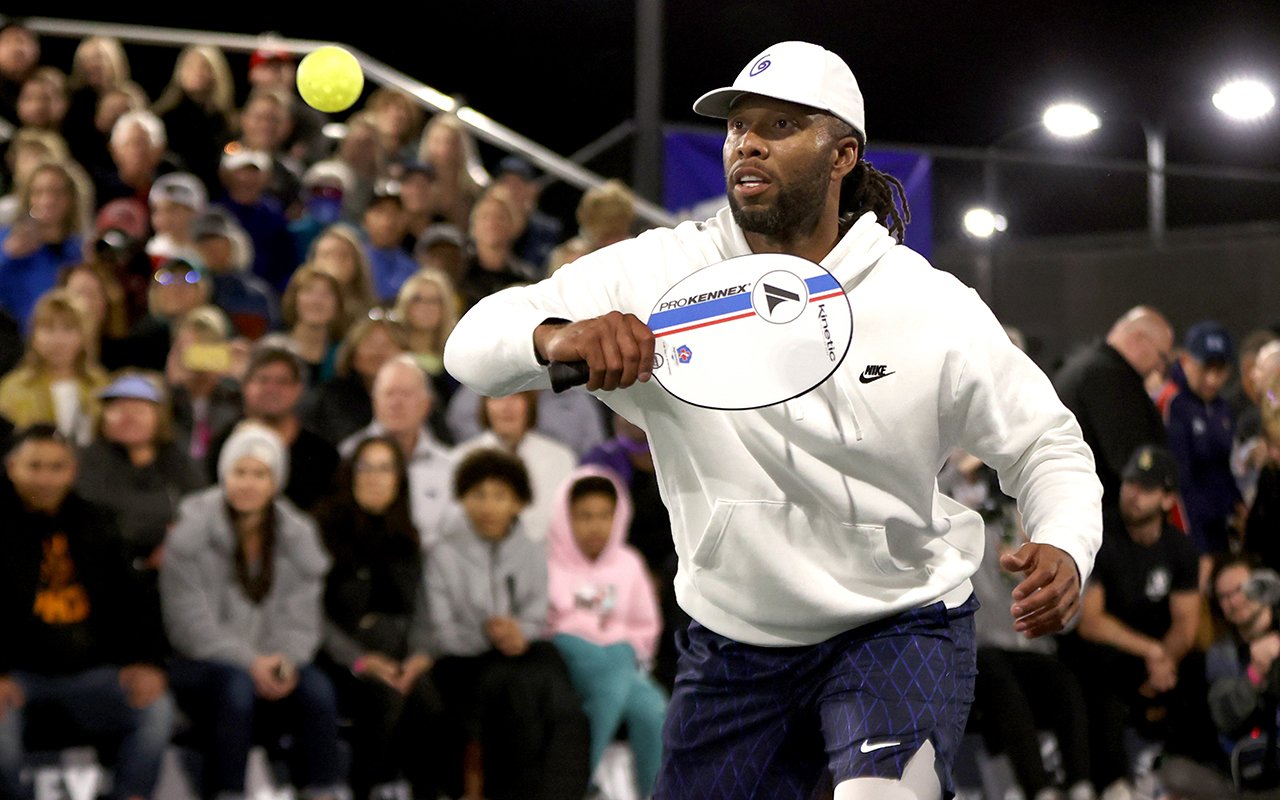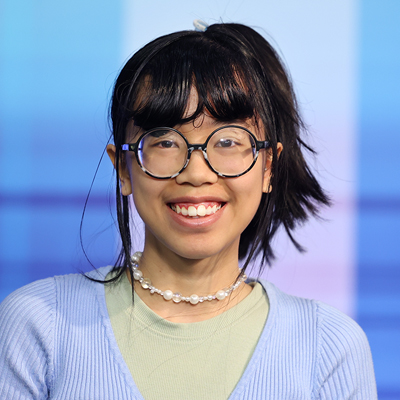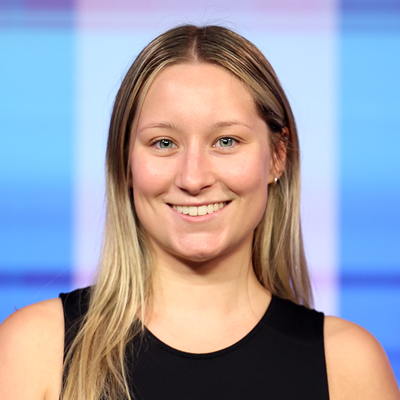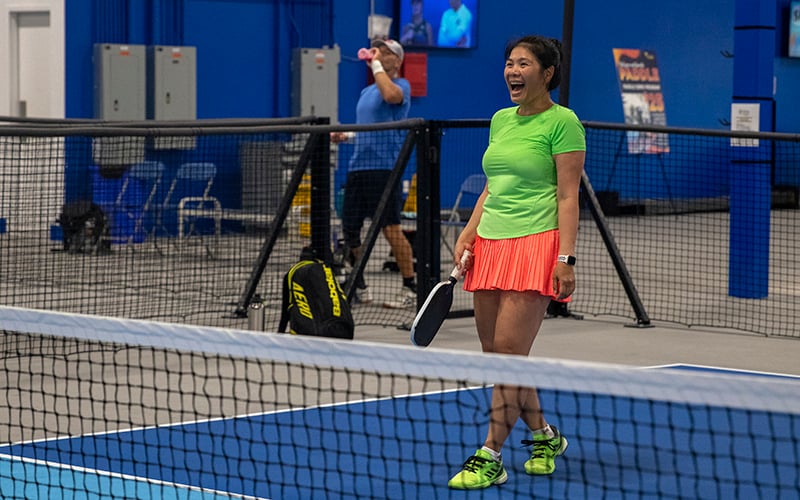
Staci Do celebrates scoring a point at Pickleball Kingdom, an indoor facility with more than a dozen courts in Chandler, on Sept. 14, 2022. (Photo by Emily Mai/Cronkite News)

Pecos Park in the Ahwatukee Foothills area of south Phoenix has 16 public courts designated for pickleball. Photo taken Sept. 14, 2022, in Phoenix. (Photo by Emily Mai/Cronkite News)
THOUSAND OAKS, Calif. – Riley Hobaica loves playing America’s fastest-growing sport, but it requires some serious time behind the wheel.
“I drive about 25 miles to get here every day,” Hobaica, 22, said on a recent busy Saturday at the courts in this bucolic city northwest of Los Angeles. “It’s a little far, but it’s pickleball, (so I) can’t stay away for too long.”
Many fans of the sport find themselves in a similar pickle when it comes to finding a place to play. Cities across the country are having a hard time providing courts, which are much smaller than tennis courts.
The shortage forces players into long commutes, lengthy courtside waits while other players finish their sets or a search for alternatives, including private sports facilities.
Pickleball is America’s fastest-growing sport, the Sports and Fitness Industry Association reports, with participation increasing 39.3% over the past two years.
Baby boomers are drawn to pickleball because it leaves them sweaty without sacrificing knees and other joints because there’s less stress and running compared to similar sports like tennis.
But pickleball – which is played with paddles instead of rackets and uses hollow plastic balls similar to Wiffle balls – has attracted players of all ages, including such famous athletes and celebrities as Olympic swimming champion Michael Phelps, comedian Jamie Foxx and Microsoft billionaire Bill Gates.

Father and son duo Alan Singer, left, and Zach Singer play pickleball at Pickleball Kingdom in Chandler on Sept. 14, 2022. (Photo by Sophie Oppfelt/Cronkite News)
That popularity, however, has come at a price as cities scramble to provide more courts while not alienating participants of other sports.
Brent Dennis, director of parks, recreation and marine in Long Beach, one of California’s most populous cities, told the City Council in April that he loves pickleball, rhapsodizing about “the melodic sound of the ball against the paddle.” But he said Long Beach had only one dedicated pickleball court – and 67 tennis courts. Many residents, he acknowledged, head to the adjoining but much smaller city of Seal Beach to play.
Under its Pickleball Master Plan, Long Beach has since made plans to add additional striping to tennis courts to make them available for paddleball play as a short term solution.
Building pickleball-only courts doesn’t come cheap. Long Beach officials estimate the cost of a dedicated pickleball court is $60,000.
Some of the same debates have been playing out in Arizona. Pecos Park in south Phoenix had 16 courts built before the pandemic, but some residents complain they aren’t enough, the Ahwatukee Foothills News reported in September. Some have campaigned to have additional courts in nearby Desert Foothills Park amid concerns of cost.
And though tennis court conversions are much cheaper, adding pickleball striping is sure to draw fire from tennis players worried that pickleball will cut into their own court time.
In May, several residents attending a City Council meeting in Coronado, California, near San Diego, voiced opposition to converting tennis courts for pickleball use, the Coronado Eagle & Journal reported.
The clash has been felt as far east as Asheville, North Carolina, where city officials were flooded with complaints this month over plans to turn three tennis courts into eight pickleball courts, WLOS-TV reported.
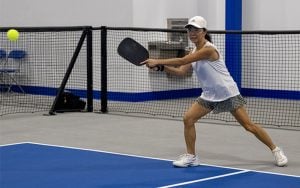
Thi Diep hits the ball across the net at Pickleball Kingdom, an indoor facility in Chandler, on Sept. 14, 2022. (Photo by Emily Mai/Cronkite News)
The shortage of pickleball courts can pit veteran players against newcomers.
“The one thing I have noticed sadly with any kind of growth is that there are growing pains,” said Beth Brooks, a California pickleball player. “Initially when I was playing, everyone was trying to get new people to play pickleball.”
But patience can wear thin when it comes to court time.
“The longer you have to wait for a court, the harder it is to be patient for a player that’s just starting, especially when all the other players are higher-level players,” Brooks said.
At present, the court shortage is especially a problem for organizations staging tournaments. They typically need not only dedicated courts, but seating for spectators as well, limiting their options.
“California, Arizona, Florida and Seattle are the major cities where pickleball is getting popular,” said Angus Lee, founder of the California Pickleball Association, “so you see a lot of courts popping up in those states, but the main issue is when tournament directors want to find a major venue that could hold up to 300 people.”
In addition to finding courts, Lee said, it’s hard to get the necessary approvals.
Most tournament directors use schools or parks to set up pickleball tournaments, but with the emergence of more players and the need for a more competitive atmosphere, the call for larger tournament venues and pickleball courts has increased.
Hobaica, the Thousand Oaks pickleball regular, said that once he gets out of his car, “It’s easy to find a pickleball court, but it takes a little bit between the games because there just aren’t enough courts at the parks or venues.”
Noise is another issue. When tennis courts are converted, the sharp thwack made by the paddles replaces the more gentle whoosh of tennis racquets, which can jar nearby homeowners. Some homeowners consider the noise overwhelming and constant.
Sarah Thomas of Newport Beach, California, sued the city in 2016, saying the noise gave her “severe mental suffering, frustration and anxiety.”
The Los Angeles Times reported that homes neighboring pickleball courts are emerging successful in legal bouts that claim pickleball is violating city noise ordinances.
But there appears to be little to stop the growth of pickleball, whether it unsettles the neighbors or not.
“If someone my age is addicted to it, I think it’s here to stay,” Hobaica said. “I got at least five different friends into pickleball, so especially in my age group, I think it’s going to keep growing.”

